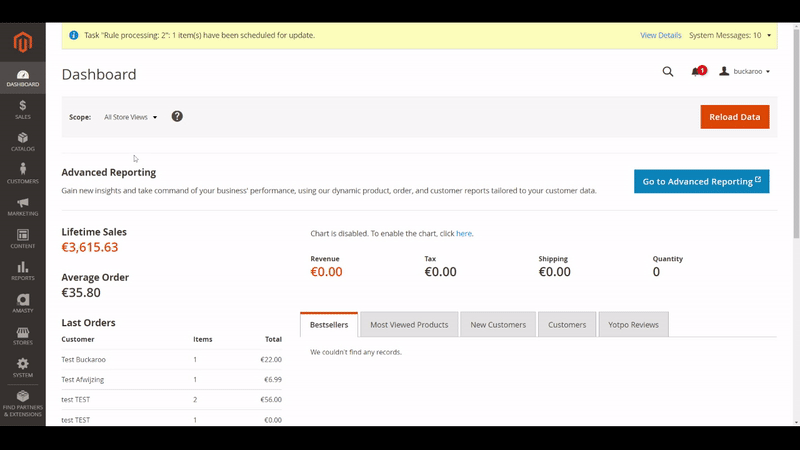Configuration
A Buckaroo account is required to perform test or live transactions with the Buckaroo plugin for Magento 2. Follow these steps to configure the plugin:
- Sign In to Magento 2 Backend:
- Navigate to Stores → Configuration in the main menu of Magento.
- Within the Sales submenu, select the Buckaroo logo to access the plugin settings.
- Complete General Configuration:
- Fill out all necessary information on the General Configuration and Account Information page.
- Refer to the descriptions below for each required credential to establish the connection between the plugin and your Buckaroo account.

Required Credentials:
- Enabled: Set this option to "Live" to enable the Buckaroo plugin.
- Secret Key:
- Create a secret key in the Buckaroo Plaza at Settings → Secret Key.
- The secret key should only contain numbers and letters. Copy the secret key once it's created.
- Merchant Key:
- Find the merchant key in the Buckaroo Plaza under Settings → Websites.
- Use the filter button to switch between multiple websites (if applicable).
- Select the desired website and go to the General tab to locate the key.
- Merchant GUID:
- Retrieve the GUID from the Buckaroo Plaza at My Buckaroo → General.
- The GUID is displayed at the top of the page and consists of a combination of letters and numbers.
- Transaction Label:
- This represents the transaction description. We recommend using your website name to ensure recognition by customers, as it will also appear on their bank statements.
- Certificate Label:
- Assign a name to the certificate that will be uploaded in the next step, such as "Buckaroo".
- Upload Your Buckaroo Private Key Certificate:
- Generate a certificate in the Buckaroo Plaza at Settings → Certificates.
- Create the certificate using the Actions button on the page.
- Save the file properly for future reference.
- Upload it in the Certificate Management tab in your Magento backend.
- Certificate Thumbprint:
- Retrieve the thumbprint from the Buckaroo Plaza at Settings → Certificates.
- The thumbprint is only visible after creating a certificate.
- Certificate File:
- Select the certificate file that was previously uploaded. Identify the certificate by its given label (name).
Remember to Save
To ensure all the necessary information is saved accurately.
Advanced Configuration
Expert Notice
It is important to note that altering the default settings without proper knowledge may have adverse effects on the workflow and performance of all Buckaroo payment methods. Therefore, these options should be used at your own risk.
Advanced Settings Examples
- Modifying payment statuses
- Adjusting redirect URLs
- Various debugging settings
- Enabling the "Keep Cart Alive" mode (restores the cart when a consumer uses the back button in the browser)
Refund Configuration
Navigate to the Refunding tab to configure the handling of refunds.
Refund Settings:
- Enabled: Determines whether refunds should be sent from Magento to Buckaroo.
- Accept Payment Plaza Refunds in Magento: Determines how manual refunds initiated from the Buckaroo Plaza should be managed.
- If Magento is solely used for stock management and no monetary refunds need to be processed, disable this option.
- If only monetary refunds are required and Magento is primarily used as a stock system, manual refunds from Buckaroo should be ignored.
- In most scenarios, enable both functions to ensure close alignment between the two systems.
Payment Method Configuration
To access the payment method configuration settings, follow these steps:
- Navigate to Payment Methods:
- Go to Stores → Configuration in the left main menu of Magento.
- Click on the Sales submenu.
- Select Payment Methods.
- Customize Settings for Each Payment Method:
- Enable Payment Method: Enable or disable the payment method by setting it to "LIVE", "TEST", or "OFF".
- Frontend Label: Specify the name of the payment method as it appears during checkout.
- Frontend Subtext: Optionally, provide a subtext to be displayed below the payment method during the checkout process.
- Frontend Subtext Style: Select the desired font style for the subtext (Regular, Italic, or Bold).
- Frontend Subtext Color: Select the desired frontend subtext colour.
- Frontend Sort Order: Specifies the sorting order of payment methods during the checkout process.
Updated 5 months ago